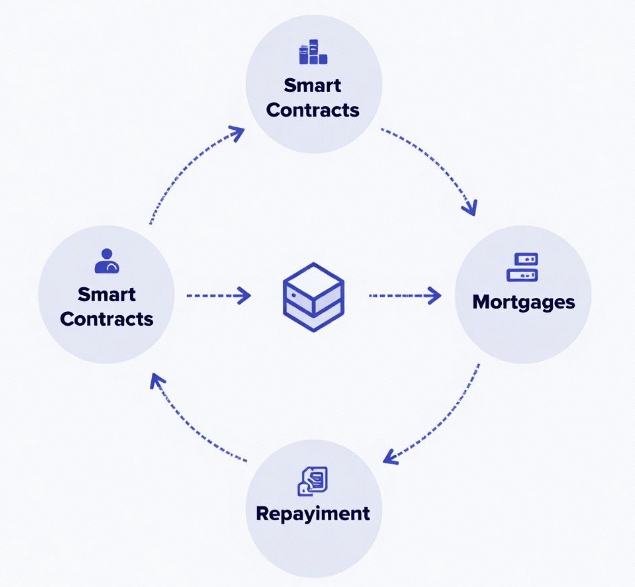Decentralized Finance (DeFi) Application Scenarios and Development of DApps
- latest articles
- 1.DApp Development & Customization: Merging Diverse Market Needs with User Experience 2.Analysis of the Core Technical System in DApp Project Development 3.How to achieve cross-chain interoperability in Web3 projects? 4.How does the tokenization of points reconstruct the e-commerce ecosystem? 5.How to Set and Track Data Metrics for a Points Mall? 6.What is DApp Development? Core Concepts and Technical Analysis 7.Inventory of commonly used Web3 development tools and usage tips 8.Development of a Distribution System Integrated with Social E-commerce 9.Six Key Steps for Businesses to Build a Points Mall System 10.What is DApp Development? A Comprehensive Guide from Concept to Implementation
- Popular Articles
- 1.Future Trends and Technology Predictions for APP Development in 2025 2.Analysis of the DeFi Ecosystem: How Developers Can Participate in Decentralized Finance Innovation 3.From Zero to One: How PI Mall Revolutionizes the Traditional E-commerce Model 4.DAPP Development | Best Practices for Professional Customization and Rapid Launch 5.Recommended by the Web3 developer community: the most noteworthy forums and resources 6.From Cloud Computing to Computing Power Leasing: Building a Flexible and Scalable Computing Resource Platform 7.How to Develop a Successful Douyin Mini Program: Technical Architecture and Best Practices 8.Shared Bike System APP: The Convenient Choice in the Era of Smart Travel 9.How to Create a Successful Dating App: From Needs Analysis to User Experience Design 10.From Design to Development: The Complete Process of Bringing an APP Idea to Life
DApp's Decentralized Finance (DeFi) Application Scenarios and Development
I. Introduction to DApps and Decentralized Finance (DeFi)
With the continuous development of blockchain technology and the proliferation of smart contracts, DApps (Decentralized Applications) have become a crucial component of the blockchain world. DApps are not limited to the financial sector but also encompass supply chain management, data storage, digital identity, and more. Decentralized Finance (DeFi) is a significant application of DApps in the financial field, revolutionizing traditional financial services through decentralization, offering users financial services without intermediaries.
DeFi is a decentralized financial system built on blockchain, redefining the operation of traditional finance through technologies like smart contracts, decentralized exchanges (DEX), and lending protocols. Unlike traditional finance, which relies on centralized institutions such as banks, insurance companies, and payment platforms, DeFi uses decentralized applications and protocols to make financial services more transparent, open, and capable of enabling global transactions and cross-border payments.
II. Core Characteristics of Decentralized Finance
The core characteristics of Decentralized Finance (DeFi) can be summarized as follows:
Decentralization: DeFi platforms use smart contracts to automatically execute transactions without the involvement of traditional financial intermediaries. Through decentralization, DeFi reduces the risk of single points of failure and enhances the stability and censorship resistance of the financial system.
Open Source and Transparency: Most DeFi protocols are open source, allowing anyone to view, use, modify, and deploy the code. The execution of smart contracts and transaction records are publicly transparent and accessible to all.
Permissionless Access: DeFi allows anyone, anywhere, to access and participate in financial services via the internet. Users only need a computing device and an internet connection to conduct transactions globally.
Automation: Through smart contracts, DeFi applications can automate various financial operations, including lending, trading, payments, and insurance. Automation reduces human error and operational costs.
III. Application Scenarios of DApps and DeFi Integration
Decentralized Finance (DeFi) has demonstrated significant potential and application scenarios across various financial sectors. Here are some typical DeFi application scenarios:
1. Decentralized Exchanges (DEX)
Decentralized exchanges (DEX) are one of the most important applications of DeFi, enabling users to trade cryptocurrencies directly without centralized institutions. Unlike traditional centralized exchanges (such as Binance, Huobi, etc.), DEX platforms do not require custody of user funds, and transactions are automatically completed by smart contracts.
Common decentralized exchanges like Uniswap and SushiSwap provide liquidity to users through automated market maker (AMM) mechanisms, addressing common market depth issues in traditional exchanges. The emergence of DEX allows users to enjoy greater privacy protection and avoid the risks associated with centralized platforms.
2. Decentralized Lending Platforms
DeFi lending platforms are another important application scenario, allowing users to lend or borrow cryptocurrencies without going through traditional banks or financial institutions. Lending protocols use smart contracts to execute operations such as borrowing, repayment, and interest payments, reducing the costs of the traditional financial system.
Representative DeFi lending platforms include Compound and Aave, which allow users to borrow by providing cryptocurrencies as collateral, with the interest paid by borrowers going to the lenders. Decentralized lending enables anyone to participate in lending, regardless of whether they meet the credit qualifications required by traditional banks.
3. Decentralized Insurance
DeFi also shows great potential in the insurance industry. Traditional insurance companies typically require significant management fees, audit processes, and intermediaries, while DeFi insurance reduces these costs through decentralization, improving transparency and efficiency. Users can purchase insurance products on DeFi platforms, with claims processed automatically via smart contracts.
For example, Nexus Mutual is a decentralized insurance platform based on Ethereum, offering an alternative to traditional insurance. Users can provide insurance for specific risks (such as smart contract vulnerabilities, platform hacks, etc.), ensuring the security of the decentralized financial ecosystem.
4. Decentralized Stablecoins
Stablecoins are another crucial component of DeFi, reducing the impact of market volatility by pegging the value of cryptocurrencies to fiat currencies (such as the US dollar). Decentralized stablecoins like DAI maintain price stability through smart contract algorithms.
The emergence of stablecoins addresses the issue of high price volatility in cryptocurrencies, enabling users to conduct more stable transactions and investments on DeFi platforms. Additionally, stablecoins have become key for lending and cross-chain payments within the DeFi ecosystem.
IV. DeFi Application Development Technologies
The development of DeFi applications relies not only on writing smart contracts but also on the support of a series of technical frameworks and tools. Here are several commonly used technologies in DeFi application development:
1. Smart Contracts and Blockchain Platforms
The core of DeFi applications is smart contracts, which define the rules and execution methods of financial transactions. Developers typically choose blockchain platforms like Ethereum, Solana, and Binance Smart Chain to deploy DeFi applications. These platforms provide efficient smart contract execution environments and support decentralized transactions and data storage.
Ethereum is one of the most widely used blockchain platforms, supporting the implementation of decentralized financial protocols through the Solidity programming language.
2. Decentralized Storage
DeFi applications typically use decentralized storage solutions like IPFS (InterPlanetary File System) or Filecoin for data storage. These decentralized storage solutions effectively prevent data leaks and tampering, ensuring the security and availability of application data.
3. Cross-Chain Technology
Cross-chain technology is crucial in DeFi, as users may need to conduct transactions or transfers between different blockchain platforms. Through cross-chain protocols (such as Cosmos, Polkadot, Chainlink, etc.), DeFi applications can achieve interoperability between different blockchains.
4. Frontend Development and User Experience
Although DeFi protocols themselves are decentralized, users still need a user-friendly interface to interact with these protocols. Frontend development technologies (such as React, Vue, etc.) and libraries for interacting with blockchains like Web3.js and Ethers.js help developers build easy-to-use DApp frontend interfaces.
V. Challenges and Future Development of DeFi
Although DeFi has brought revolutionary changes to the financial industry, it still faces several challenges:
Security Issues: Although DeFi protocols achieve decentralization through smart contracts, smart contract code may have vulnerabilities or be attacked, leading to financial losses.
Regulatory Issues: Due to the decentralized nature of DeFi applications, traditional financial regulators face challenges in effectively regulating them.
User Education and Trust Issues: DeFi remains unfamiliar to many ordinary users, and improving user trust and usability is a key focus for future development.
With technological advancements and ecosystem improvements, DeFi will continue to innovate and develop, attracting more users and developers. In the future, DeFi may further penetrate the traditional financial sector, becoming an important component of the global financial system.
Conclusion
Decentralized Finance (DeFi) is a significant innovation in blockchain technology, offering users a new way of accessing financial services through decentralized applications (DApps). As DeFi application scenarios continue to expand and technology matures, we have reason to believe that DeFi will occupy an increasingly important position in the future financial system. For developers, seizing the opportunities in DeFi development and gaining a deep understanding of its technologies and application scenarios will help them meet future challenges and opportunities.
-

DApp Development & Customization: Merging Diverse Market Needs with User Experience
As blockchain technology matures and becomes more widespread, decentralized appl···
-

Analysis of the Core Technical System in DApp Project Development
With the rapid development of blockchain technology, decentralized applications ···
-

What is DApp Development? Core Concepts and Technical Analysis
With the rapid development of blockchain technology, decentralized applications ···

 Blockchain
Blockchain












